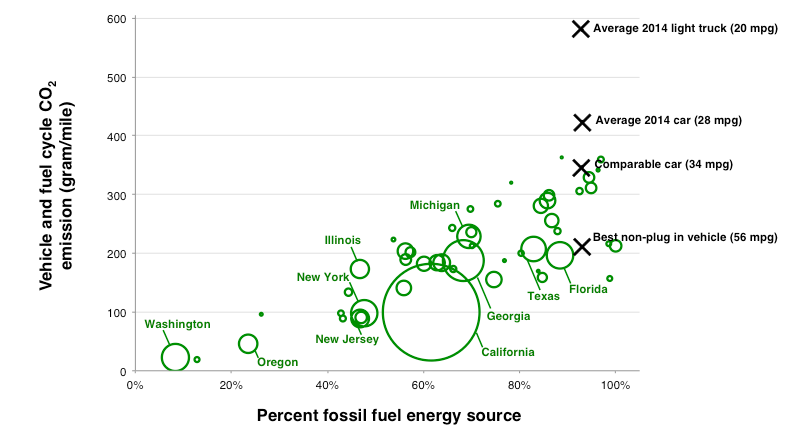Global climate change mitigation potential from a transition to electric vehicles
Blog
Turning over a new leaf: Electric vehicle carbon emissions
A few times a year, a news story appears about electric vehicles having high carbon emissions, throwing doubt onto electric vehicles’ ability to play a major part in any low-carbon transportation future. With the New Year still young, let’s resolve to assess the data, get to the bottom of things, and stay well informed on all our low-carbon technology options.
Electric versus gasoline vehicles
Stories like this one highlight how power from coal-fired generating facilities partially powers electric vehicles, suggesting that clean electric vehicles are not quite here yet. That story focused on the Netherlands, which gets about 29% of its electricity from coal. And it’s true that coal-generated power flows through the electricity grid most everywhere. But the story could have done a much better job in answering the real question, which is whether (and where) electric vehicles are cleaner than their non-EV counterparts.
Luckily, there is a lot of data available to answer that question. The case of the U.S., where the electricity supply is even more coal-dependent in many areas than in the Netherlands, is quite instructive. A recent Union of Concerned Scientists study added up the carbon emissions through the vehicle life cycle and estimated U.S. vehicle carbon emissions as averaging 68 miles per gallon fuel economy equivalent, about two and a half times better than average gasoline cars. In places like California, the Pacific Northwest, and New York, where coal is a relatively small proportion of the energy mix, EVs were even cleaner. Even in regions of the country that are still big coal users, electric vehicles handily beat the average car on carbon emissions. This is true because electric vehicles are typically 3 to 5 times more efficient in using energy than combustion vehicles.
We took a look at the recent US EPA “eGrid” data on electricity generation carbon emissions. Then we combined this with data on where new electric vehicles are registered state-by-state. The figure below shows carbon emissions versus the percentage of electricity generation from fossil fuel sources for each state. The size of the bubbles represents electric vehicle sales in 2014. California is highest with almost 60,000 vehicles, and the other top-10 electric vehicle sales markets are also labeled. We use electric vehicle efficiency of 0.3 kWh per mile, which is the efficiency of the popular Nissan Leaf, and include factors like transmission losses and upstream energy emissions as EPA does.

Electric vehicle carbon emissions and fossil fuel energy source (and electric vehicle sales as size of bubbles), compared to gasoline vehicles in the U.S.
What we see, quite clearly, is that electric vehicles’ average carbon emissions tend to vary with the amount of fossil fuel (mostly coal and natural gas) in a state’s electricity generation mix, but they are reliably lower than conventional gasoline vehicles. The chart also plots various US average gasoline vehicles from US EPA “Trends” and fueleconomy.gov data. Based on these data, the average U.S. electric vehicle has about 60% lower carbon emissions than the comparable 34-mpg conventional vehicle and about 70% lower emissions than the average 28 mpg car. And another way to show how much cleaner electric vehicles are than conventional cars is by comparison to highest-mpg gasoline-only car – the estimated 56-mpg 2016 Toyota Prius. Considering that light trucks are now over half of US light-duty vehicle sales, the average 20 mpg light truck is shown for context. As shown, the average U.S. light truck emits about twice as much carbon per mile driven as a Nissan Leaf in the states that have the highest coal generation.
Getting cleaner with age
Beyond already having lower emissions from the start, electric vehicles are the only vehicles that get substantially cleaner with age. How is this possible? Whereas conventional vehicles must burn whatever the oil industry refines and delivers to fuel pumps, with some ethanol blended in, electric vehicles are powered by a dynamic electric grid that keeps shifting to lower-carbon energy sources. The grid continues to get cleaner, shifting to more renewable sources, due to states’ renewable power regulations, carbon trading schemes (like RGGI and California’s), and, going forward, the federal Clean Power Plan. Of course, there are places that are also working to de-carbonize the vehicle fuel supply with low-carbon biofuels too, but the grid is de-carbonizing much quicker.
So the grid itself is turning over a new leaf. The primary energy generation that is transmitted on the U.S. electric grid, the world’s second largest, is shifting one power plant, wind farm, and solar array at a time. The data in the figure below from U.S. EIA show how, in just seven years, the U.S. grid has (1) reduced its share from coal by about a third, (2) increased its share from natural gas by 60%, and (3) steadily increased its share of low-carbon renewable plus nuclear power. The changes are coming fast enough that even the analysis and figure above (and really all other analysis) does not yet incorporate the lower 2015 CO2 emissions yet. Furthermore, as pointed out elsewhere, electric vehicles will enable and accelerate ever further greening of the grid.
Perhaps society at large is turning over a new leaf on electric vehicles. Consumers in many markets are increasingly turning to EVs. Electric vehicle sales are about double in 2015 versus 2014 in auto markets like China, France, the United Kingdom, and the Netherlands. And while electric vehicle sales are up, the grid emissions keeping getting lower.
So let’s resolve to track how this trend continues to keep further cleaning up electric vehicles’ already-low emissions. Perhaps we are all closer to accepting that electric-drive vehicles are not just the future’s low-carbon transportation option, but are also the lowest carbon option available in today’s vehicles.

